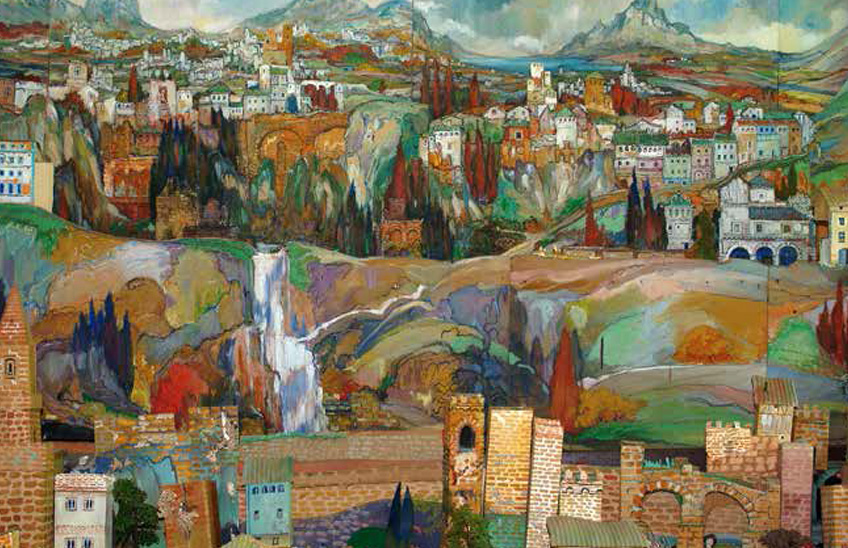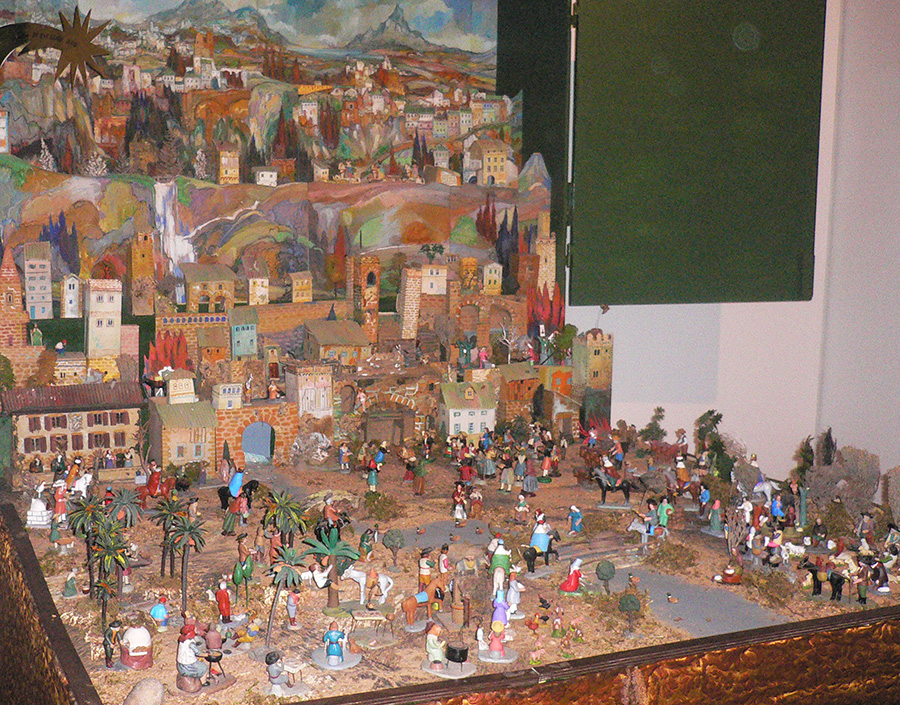The Nativity Scene and Mr. Julio Caro Baroja

PhotoC. Jusué/Backdrop of the nativity scene of Don Julio Caro Baroja in Itzea.
Well into the last century and when the historicist nativity scenes were gaining ground over the popular and traditional ones, Don Julio Caro Baroja recorded in his reflections and experiences about the sets that he had contemplated in his childhood, before the workshops of Olot flooded the market of figures with their historicist models with landscapes and orientalist models, along with the studied perspectives of numerous dioramas.
Julio Caro Baroja (1914-1985) included his text on the topic in the book Memorias familiares, first published in 1972, evoking the market of the place de la Santa Cruz in Madrid back in the twenties of the twentieth century, with the stalls of stalls, models for pesebres, figures and Christmas instruments. He distinguishes the origins of the figures, with a majority from Murcia and other fine ones from Granada, heirs of the nineteenth-century Andalusian muds, "from the most atarugadas and coarse, painted with bright colors, to the most delicate, there was also an appreciable difference in price". In addition to the characters of the Gospels, he lists "the chestnut seller, the woman who spins with her isolated cat, the baker, the old woman with the zambomba, the solitary shepherd, or the groups: the Holy Family in front of the inn, the miller, the Annunciation to the shepherds, the man with his yoke. All the old peasant society of the South could be found represented in figures and groups, independently of the physical training or agreement toa canon of the Christmas Nativity". He admits that it is in these latter types that he took delight: "But to me, I was more interested than the central figures, than the Magi or Herod with his soldiers (reminiscent of the "armaos" of the Holy Week Processions of the South), in the humble characters that in the southern, Catholic society of Italy, Spain, Provence or South Germany, I had imagined that they had gone to pay homage to the child-God, at onetime.Nor was I interested in them because I thought they were humble or poor in spirit, but because it amused me to think of their daily chores, of their yokes, wells, fountains with pitchers and donkeys with bucklers, of their spinning gear or other tasks. He played long hours adjusting his life. My uncle Pío collaborated in this, giving interpretation to the characters created by the popular image makers".
With this experience staff ends the story: "You will understand, then, the joy and illusion that I had, at nine and ten years old, when my grandmother and my father gave me a very respectable amount of pesetas in silver according to my account and accompanied and even advised by Julia I went up Main Street, to see nativity scenes, and arrived at the Santa Cruz market, to fill in, to expand my collection of figures. The groups were what most tempted me, and so I came to have many that served me as toys during the winter, although my grandmother used to want me to close the cycle, according to the canonical dates and to keep the figurines in protocol".
The nativity scene in his house in Vera de Bidasoa, in Itzea, has a background painted by himself, to which his niece Carmen Baroja refers, in her study of Julio Caro Baroja as a painter, with these words: "my uncle ... painted a fantastic landscape for the background, quite un-Israelite, but very Penibetic, with gorge, arch, waterfall and southern houses, which extraordinarily enriched the scenery. As the collection of figurines grew, it was necessary to join two tables and paint another background for the distance, create a wooden structure behind to keep them at different levels and achieve the perspective and the effect of distance. Already with this birth of certain dimensions, we organized even dances .... This was great fun for my uncle Julio and he enjoyed so much festivity in front of his work. When my brother was born in 1969 my mother decided that she did not want to spend cold in the countryside at Christmas in Malaga and we moved to spend the holidays in Vera with the nativity on our backs. At the beginning it was kept every year, but there we created the current structure of six planes and incorporated as a novelty the architecture that is made with cardboard boxes painted by my uncle ...... I say that my uncle was always fond of nativity scenes, because wherever he saw beautiful figures, he would buy them, touch them up with his brushes in the background, fix a house, glue the leg to a lamb, and in this way he kept it properly".

Nativity scene of don Julio Caro Baroja in Itzea. Photo C. Jusué
The figures that populate the set are mostly from Murcian and Andalusian workshops, some are even repeated. Many of them were gifts from the visits that Don Julio received in Itzea. As in other traditional nativity scenes, there we find dancers and musicians, inns, trades typical of traditional and pre-industrial society and, of course, the exceptional protagonists, shepherds, shepherdesses, farm workers and farmers in all class of agricultural work. In contrast to all these characters of daily life, the only ones that stand out for their splendor and wealth are the repeated parades of the Three Wise Men.
LEARN MORE
CARO JAUREGUIALZO, C., "El ingenio de Julio Caro Baroja como pintor: inventario de sus cuadros", Cultura y patrimonio de los pueblos de España. seminar commemorativo del centenario de don Julio Caro Baroja, Madrid, Ministerio de Cultura, 2019, pp. 294-383.
FERNÁNDEZ GRACIA, R., Historical Nativity Scenes in Navarra. Figures for the report, Pamplona, Pamplona, Chair de Patrimonio y Arte Navarro, 2005.
FERNÁNDEZ GRACIA, R., To Bethlehem shepherds! Historical Nativity Scenes in Navarra, Pamplona, Government of Navarra-Pamplona City Council, 2007.
